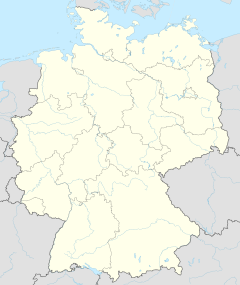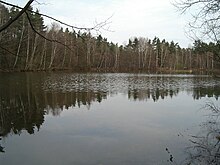Sebalder Reichswald
| Sebalder Reichswald | ||
|---|---|---|
|
|
||
| Location: | Bavaria , Germany | |
| Specialty: | Forest | |
| Next city: | Nuremberg | |
| Surface: | 10,000 ha | |
| Founding: | about 800 | |
The Sebalder Reichswald is the part of the Nuremberg Reichswald north of the Pegnitz ; to the south is the Lorenzer Reichswald .
It covers an area of approx. 10,000 ha and extends approx. 25 km wide on the axis Erlangen - Lauf ; the northern border is formed by the Schwabach river .
The name comes from St. Sebald , the main church of the Nuremberg district of the same name and north of the Pegnitz .
history
Around 720 the Reichswald was placed under the Franconian royal ban. Through overuse and subsequent reforestation, the original pine-birch-oak mixed forest was transformed into a pine forest.
The Sebalder Reichswaldhalle was 1024 by Kaiser Heinrich II. The high pin Bamberg transmitted; Emperor Heinrich III. struck him back to the Reichsgut around Nuremberg. The forest was administered as an imperial fief by a forester. Since 1273 the burgraves of Nuremberg were enfeoffed and incorporated it into their office in Heroldsberg. In 1385 the forest of the imperial city of Nuremberg was pledged.
In 1427, the burgrave Friedrich IV. Sold the forest to the city of Nuremberg, but retained some rights that gave rise to many quarrels in the following centuries. In 1489 the administration of Lorenzer and Sebalder Reichswald was standardized by "forest offices". The approximately 11,500 hectares were originally divided into six, from the 15th century on into ten forest huts.
In 1810 the forest came to the Kingdom of Bavaria together with Nuremberg. Due to overuse it was once again in a deplorable condition. The pine monocultures were largely destroyed by the pine spanner in 1896. A third of the total area had to be cut down. In the following years it was again extensively reforested with pine trees. The characteristic appearance of the pine forest has earned it the name "Stecklaswald".
During the First and Second World Wars , large areas for military installations (ammunition stores, training areas, firing ranges) were lost. In the 1930s, sections of the Regensburg – Frankfurt autobahn (now the A 3 ) were built through the forest and completed and expanded after the Second World War. The only other major project was the construction of the airport (opened in 1955). In addition, the Sebalder Reichswald - in contrast to the Lorenzer - recorded only minor losses in area.
With the emergence of environmental protection at the beginning of the 1970s, its ecological function and its use as a recreational area became more important. On August 1, 1979, the Sebalder Reichswald was the first forest in Bavaria to be declared a forest and protected. However, this protection appears to be of limited effectiveness. There are plans to create an additional north connection from Nuremberg Airport to the A3 through the Sebalder Reichswald. The project is currently on hold due to soil contamination at Nuremberg Airport.
Military use
The forest was used for military purposes in various places by the Reichswehr and the US Army. Among other things, this leads to the fact that to this day in a large part of the forest leaving the paved paths is forbidden due to the danger of ammunition.
geography
The Sebalder Reichswald includes the Tennenloher Forest , Buckenhofer Forest , Dormitzer Forest , Kalchreuther Forest , Neunhofer Forest and Kraftshofer Forest , Erlenstegener Forest , Behringersdorfer Forest , the community-free area Geschaidt , the Rückersdorfer Forest and the Günthersbühler Forest . In Erlenstegener Forest, just off the highway, is the Weissensee , the Albrecht Dürer in watercolors painted.
Only in a few places, the forest exceeds the 400-m-high mark (eg at Mistelberg (418 m) in. Kalchreuth which m is high even 413, and today the Schmalzberg (406 m) in the district Ludwigshohe the community Rückersdorf located ).
The soil is mostly sandy and regularly planted with pines; sometimes birch or alder are mixed in. In addition, it is mostly overgrown with bilberry or lingonberry bushes. The Sebalder Reichswald is thus an important part of the Franconian sand axis .
Some areas, especially the Erlenstegen Forest, are criss-crossed by numerous drainage ditches. After periods of heavy rainfall, the flatter parts of the Reichswald are swampy for some time . H. the forest acts as a water reservoir, but forest fires can occur in periods of drought.
Monuments and memorial stones
In the forest there are a number of monuments, memorial stones, wells, springs and other special features. This includes u. a .:
- The Bannwald monument in the Dormitzer Forster recalls the declaration of the Sebalder Reichswald as a Bannwald.
- The Fuchsstein in the Buckenhofer Forest was erected in 1976 and is a reminder of the occurrence of foxes in the forest.
- The hare stone column shows a hare with five legs.
- The Gesundbrunnen between Buckenhof and Uttenreuth was already valued in the 18th century for its carbonated water. Today, however, hardly any water flows out of it.
- In the vicinity of the Ohrwaschl quarry in the Tennenloher Forest are the Ohrwaschl Bridge and the remains of the former Ohrwaschl inn. This was closed because of the impairments caused by target practice by the US Army and later dismantled.
- Several stone crosses , probably from the late Middle Ages , including the White Cross , the Siebenstein , the Fuhrmannsstein in the Tennenlohe Forest and the Frauenkreuz in the Kraftshofer Forest .
- The famous painter immortalized the Dürer spring at the edge of the forest near Kalchreuth in the picture Quelle im Wald with Antonius and Paulus .
- The seven meter high Franz Köhl Tower near the Gründlacher Berg was built in 1936 to observe target practice.
- The Rote Marter marks the border point between the Tennenloher, Neunhofer and Dormitzer forests, the Wolfs-Marter that between the Neunhofer, Kraftshofer and Dormitzer forests.
In 2016, many prominent places were marked with signs.
There is also an online map for this: Monuments in the Nuremberg Reichswald. Retrieved July 15, 2017 .
Educational and recreational facilities
- In the Tennenloher Forest there is an enclosure with wild horses .
- There is a wild boar enclosure in the Buckenhofer Forest .
- Between Kalchreuth and Neunhof, an enclosure with fallow deer and goats can be observed from a high stand.
- South of Kalchreuth there has been the Kalchreuth – Wolfsfelden soil educational trail with ten stations since 2003. The first station is on Wolfsfelder Wiese on the road from Kalchreuth to Neunhof. There is an educational forest trail east of Ziegelstein (Nuremberg) .
- The Nuremberg Golf Club is located north of Nuremberg Airport and south of the A3 motorway in the Kraftshofer Forst .
See also
literature
- Erlangen Forestry Office: Memorial stones, sources and other special features in the Sebalder Reichswald, 2004, ISBN 3-00-014252-5 .
- August Gebeßler : City and district of Erlangen (= Bavarian art monuments . Volume 14 ). Deutscher Kunstverlag, Munich 1962, DNB 451450949 , p. 146 .
Individual evidence
- ^ A b Walter Bauernfeind: Sebalder Reichswald . In: Michael Diefenbacher , Rudolf Endres (Hrsg.): Stadtlexikon Nürnberg . 2nd, improved edition. W. Tümmels Verlag, Nuremberg 2000, ISBN 3-921590-69-8 , p. 968 ( online ).
- ↑ PFC at the airport: soil remediation will take many years. Retrieved May 19, 2019 .
- ↑ | Bavarian State Forests: New information signs in the Sebalder Reichswald





